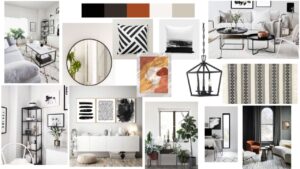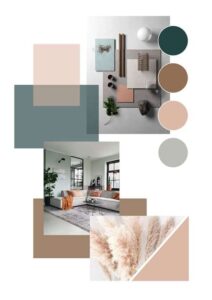Creating Effective Moodboards: A Guide for Interior Designers

Creating Effective Moodboards: A Guide for Interior Designers A moodboard is a visual tool that gathers inspirations, ideas, and potential design elements into a cohesive layout. It helps interior designers and clients envision and refine the aesthetic direction of a design project. Moodboards are pivotal in transforming abstract concepts into tangible plans, ensuring that every design choice resonates with the intended style and function.
A moodboard is a visual tool that gathers inspirations, ideas, and potential design elements into a cohesive layout. It helps interior designers and clients envision and refine the aesthetic direction of a design project. Moodboards are pivotal in transforming abstract concepts into tangible plans, ensuring that every design choice resonates with the intended style and function.
A survey conducted among professional designers reveals that 82% of designers who consistently use moodboards report better alignment with their clients’ expectations, ultimately leading to a 30% faster decision-making process compared to projects without moodboards.
The Importance of Diligence in Moodboard Creation
Creating a moodboard requires more than just compiling images and materials. It demands a thoughtful assembly of elements to narrate the visual story of a project. A well-crafted moodboard not only serves as a blueprint for the design but also enhances communication between the designer and the client, mitigating misunderstandings and streamlining the design process.
The Process of Creating an Effective Moodboard:
1. Objective Setting: Clearly define what you want your moodboard to achieve. Is it about the color palette, furniture style, or the overall vibe of the space?
2. Gathering Inspiration: Collect visual elements that inspire you. Utilize resources like design blogs, Pinterest, and industry magazines to gather images, color swatches, and textures.
3. Choosing the Format: Decide whether a digital or physical moodboard suits your needs. Digital moodboards are versatile and easily sharable, while physical boards allow for a tactile experience, which can be beneficial in material-heavy projects.
4. Arrangement and Layout: Begin with a focal point and build around it. Maintain balance and cohesion by considering color schemes, textural contrasts, and spatial relationships.
5. Refinement: Review your moodboard with fresh eyes or a peer to ensure it accurately reflects the project’s goals. Adjust elements as needed to achieve the right mix of inspiration and clarity.
6. Presentation: Present the moodboard to your client in a way that articulates the vision clearly. Use this opportunity to confirm the project direction and make necessary adjustments based on feedback
Moodboards aren’t just about placing images and materials together; they are about weaving a story that captures the essence of your design philosophy. By honing your moodboarding skills, you increase project coherence, enhance client communication, and foster creative expression.
 Importance of Moodboards:
Importance of Moodboards:
Visualization: Moodboards translate abstract ideas into tangible elements, helping clients visualize the potential of a space.
Communication: They bridge the gap between designer and client, ensuring both parties are aligned with the vision.
Efficiency: Moodboards streamline the design process by establishing a clear aesthetic direction from the outset, reducing time spent on revisions.
Statistics Highlight: According to a recent survey, 78% of interior designers found that using moodboards significantly improved client satisfaction and project turnaround time.
Investing time in crafting a detailed and thoughtful moodboard can significantly impact the success of a design project. It not only ensures that the designer’s vision aligns with client expectations but also enhances overall project efficiency and creativity. By mastering the art of moodboard creation, interior designers can elevate their professional practice and deliver results that truly reflect their clients’ desires.
